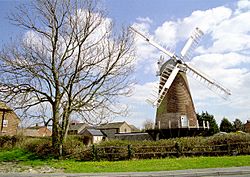Ovenden's Mill, Polegate facts for kids
Quick facts for kids Polegate Windmill |
|
|---|---|

The mill in 1997
|
|
| Origin | |
| Mill name | Ovenden's Mill Mockett's Mill |
| Mill location | TQ 582 041 |
| Coordinates | 50°48′54″N 0°14′38″E / 50.815°N 0.244°E |
| Operator(s) | Private |
| Year built | 1817 |
| Information | |
| Purpose | Corn mill |
| Type | Tower mill |
| Storeys | Four storeys |
| No. of sails | Four sails |
| Type of sails | Patent sails |
| Windshaft | Cast iron |
| Winding | Fantail |
| Fantail blades | Six blades |
| Auxiliary power | Engine |
| No. of pairs of millstones | Two pairs, a third pair driven by engine |
Polegate Windmill, also known as Ovenden's Mill or Mockett's Mill, is a historic tower windmill in Polegate, East Sussex, England. It is a special building, listed as Grade II*. This means it is very important historically.
The windmill has been repaired over the years. However, its tower is currently not open to visitors. There is an impressive museum about milling inside. This museum is open on certain special days. You can find more details on the "Polegate windmill" Facebook page. The first open day is usually during National Mills weekend.
Contents
History of Polegate Windmill
Building and Early Years
Ovenden's Mill was built in 1817. It used wind power to grind grain until 1943. After that, it used other engines to help. First, it had an auxiliary engine. Later, it used an electric motor until 1965.
Restoration Efforts
By the time the mill stopped working, it was falling apart. It was becoming "derelict," meaning it was in very poor condition. The Eastbourne and District Preservation Trust bought the mill and its land. A company called E Hole and Sons, who were millwrights from Burgess Hill, restored it. Millwrights are people who build or repair mills.
In July 1974, one of the new "stocks" broke. Stocks are the main beams that hold the sails of the windmill. This stock was only seven years old. When it broke, it brought a sail down with it.
Continued Repairs and Upgrades
In May 1976, new millwrights from Alford, Thompson's, fixed the mill. They put in a new stock and two new sails. More restoration work happened in 2004. This included adding a "cowl" to the building next to the mill. A cowl is a hood-like cover. In 2009, two more new sails were added to the windmill.
How Polegate Windmill Works
Ovenden's Mill is a four-storey brick tower mill. This means it has four levels and is built from bricks. It has a rounded top called a "domed cap." A "fantail" helps the cap turn to face the wind. The fantail is a small windmill at the back of the cap.
There is a platform, or "stage," at the first floor level. The mill has four "Patent sails." These are special sails that can adjust automatically to the wind. They are held on a "cast iron Windshaft." This is a strong metal shaft that turns the machinery.
The "Brake Wheel" is made of wood. It helps control the speed of the mill. The mill used to turn two pairs of "overdrift millstones." These stones grind grain from above. A third pair of millstones was "underdrift." These were powered by an engine from below. The tower itself is about 45 feet (13.7 meters) high to the "curb." The curb is the circular track at the top where the cap turns.
Millers of Polegate Windmill
A miller is a person who operates a mill. They are responsible for grinding grain into flour. Here are some of the people who worked as millers at Polegate Windmill:
- Joseph Seymour (1817–1857)
- Mathias Mockett (1857–)
- George Thomas
- Ephraim Ovenden (1918–)
- Albert Ovenden (–1965)

